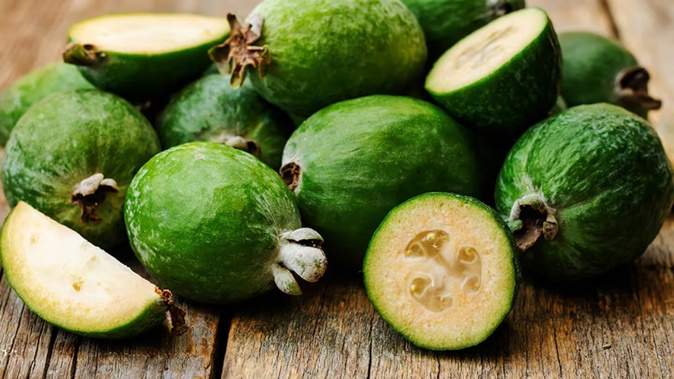
By Simon Wraight of RNZ
This time each year, Melbourne based Kiwis make a special mission to find their feijoa hit. Aussies don’t seem to get what all the fuss is about.
When it cools down and autumn hits in New Zealand, office kitchens and staff rooms are suddenly abundant with the sweet smell of our widely available little fruit – the feijoa.
But spare a thought for Kiwis who have made Australia home – where they don’t seem to understand our feijoa fantasy.
Piera Maclean, who has lived in Melbourne for a decade, longs for the taste.

Mary's feijoa and orange cake — moist and dangerously delicious.
“Normally at this time of year in New Zealand everyone’s having feijoa crumble all the time and making cakes. They’ve got so many. Whereas here it’s like if you find three, you know you’re feeling very lucky and it’s the best day ever.”
Fellow Melbourne based New Zealander Bec Lister, who has lived across the Tasman for 13 years, shares Maclean’s yearnings.
“I love autumn in Melbourne, it’s probably my favourite time of year in Melbourne, but I also know of all of the feijoas that I’m missing out on.”
Both have found ways to source the fruit in Melbourne, which occasionally means paying prices that would make many Kiwis’ eyes water.
Maclean has seen them selling on Facebook Marketplace for about AU$15 (about NZ$16.10) a kilo, but when she was hit with a feijoa craving while in a fruit shop, she paid far more.
“I picked a few out thinking these will probably cost me but might not be too bad. When I took them over, she said, oh, that’ll be $2.49 (AUD) each. I paid $7.50 (AUD) for three medium-sized feijoas.”
Feijoa and apple crumble pie. Photo / Babiche Martens
New Zealander Jen Jones, who has called Melbourne home for 13 years, has seen some other novel ways New Zealanders source feijoas.
“There’s the Facebook good karma networks and things where people would say, ‘hey, I’m here from New Zealand, I’m craving for feijoas. Does anyone have any?’”
But Jones enjoys foraging for the fruit in her local neighbourhood.
“We ride our bikes down the laneways and just collect feijoas, and sometimes we even go up to a door and say, ‘hey, we’ve noticed you’ve got all this fruit on the ground, do you mind if we collect them?’”
Jones says finding a good tree is a year-round mission.
“Through the year, you drive around and feijoa trees are on the radar. You kind of just log it in your mind and know that when autumn comes around, you might just drop by and see how it’s going.”
For Lister, a generous workmate has provided her a steady supply this season. She sits with another New Zealander in the staff room at the school where they work spooning out the juicy flesh.
“There was a massive bowl of feijoa skins just on our desk … all of our workmates were just like sitting around, being like, ‘what the hell is going on? What are these things?’”
Mark O’Connor, an Australian poet and self-proclaimed “feijoa expert”, explains why the feijoa has “not been taken all that seriously as a fruit” outside of New Zealand.
“When they were setting up the city of Canberra, which was an artificial city set up as a capital, when you arrived you had a right to get something like six free trees from the government nursery and 40 free shrubs.”
Feijoas were counted as a shrub and were recommended due to their ability to tolerate the soil and climate of Canberra. But they were never prioritised for eating.
“All over Australia, almost any nursery will have feijoas in it for sale at any time. But they will not be selected for fruit.”
O’Connor explains this has led to a low opinion of feijoas as fruit, and many people consider them as similar to a loquat and other trees where the fruit is “not taken seriously” and considered only good for jam.
O’Connor grows feijoas in his Canberra backyard and is often giving them away - there are no surprises who his main beneficiaries are.
“I certainly give them away in bucket loads, especially to people from New Zealand.”
O’Connor is interested in cultivating the fruit, and is in awe of the state of play in New Zealand.
“You don’t know how lucky you are in New Zealand that you can go to Bunnings and find half a dozen of the very best varieties on sale for really the price of seedlings.”
While Australian-based New Zealanders may be misunderstood for devouring feijoas, Lister describes it as something of a comfort.
“You do get homesick. I guess that’s one thing that can kind of comfort you is having that love for feijoas.”
Which is something echoed by Jones.
“There’s a bit of a homesickness that comes with it, and you end up more keen for them than you probably would if you were back home. It’s more than just eating the fruit, it’s a bit of nostalgia. It’s a taste of home.”
Lister also has some advice for Australians.
“You can treat Kiwis like shit all year round, but if you bring them feijoas on one day they will love you for life.”
-RNZ
Take your Radio, Podcasts and Music with you









